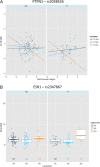Validating genetic markers of response to recombinant human growth hormone in children with growth hormone deficiency and Turner syndrome: the PREDICT validation study
- PMID: 27651465
- PMCID: PMC5097129
- DOI: 10.1530/EJE-16-0357
Validating genetic markers of response to recombinant human growth hormone in children with growth hormone deficiency and Turner syndrome: the PREDICT validation study
Abstract
Objective: Single-nucleotide polymorphisms (SNPs) associated with the response to recombinant human growth hormone (r-hGH) have previously been identified in growth hormone deficiency (GHD) and Turner syndrome (TS) children in the PREDICT long-term follow-up (LTFU) study (Nbib699855). Here, we describe the PREDICT validation (VAL) study (Nbib1419249), which aimed to confirm these genetic associations.
Design and methods: Children with GHD (n = 293) or TS (n = 132) were recruited retrospectively from 29 sites in nine countries. All children had completed 1 year of r-hGH therapy. 48 SNPs previously identified as associated with first year growth response to r-hGH were genotyped. Regression analysis was used to assess the association between genotype and growth response using clinical/auxological variables as covariates. Further analysis was undertaken using random forest classification.
Results: The children were younger, and the growth response was higher in VAL study. Direct genotype analysis did not replicate what was found in the LTFU study. However, using exploratory regression models with covariates, a consistent relationship with growth response in both VAL and LTFU was shown for four genes - SOS1 and INPPL1 in GHD and ESR1 and PTPN1 in TS. The random forest analysis demonstrated that only clinical covariates were important in the prediction of growth response in mild GHD (>4 to <10 μg/L on GH stimulation test), however, in severe GHD (≤4 μg/L) several SNPs contributed (in IGF2, GRB10, FOS, IGFBP3 and GHRHR).
Conclusions: The PREDICT validation study supports, in an independent cohort, the association of four of 48 genetic markers with growth response to r-hGH treatment in both pre-pubertal GHD and TS children after controlling for clinical/auxological covariates. However, the contribution of these SNPs in a prediction model of first-year response is not sufficient for routine clinical use.
© 2016 European Society of Endocrinology.
Figures





Similar articles
-
A pharmacogenomic approach to the treatment of children with GH deficiency or Turner syndrome.Eur J Endocrinol. 2013 Jul 29;169(3):277-89. doi: 10.1530/EJE-13-0069. Print 2013 Sep. Eur J Endocrinol. 2013. PMID: 23761422 Free PMC article. Clinical Trial.
-
GHR and VDR genes do not contribute to the growth hormone (GH) response in GH deficient and Turner syndrome patients.J Pediatr Endocrinol Metab. 2010 Aug;23(8):773-82. doi: 10.1515/jpem.2010.127. J Pediatr Endocrinol Metab. 2010. PMID: 21073120
-
Adherence to treatment in children with growth hormone deficiency, small for gestational age and Turner syndrome in Mexico: results of the Easypod™ connect observational study (ECOS).J Endocrinol Invest. 2020 Oct;43(10):1447-1452. doi: 10.1007/s40618-020-01218-4. Epub 2020 Apr 1. J Endocrinol Invest. 2020. PMID: 32239476 Free PMC article.
-
Observed and predicted total pubertal growth during treatment with growth hormone in adolescents with idiopathic growth hormone deficiency, Turner syndrome, short stature, born small for gestational age and idiopathic short stature: KIGS analysis and review.Horm Res Paediatr. 2011;75(6):423-32. doi: 10.1159/000324117. Epub 2011 Feb 25. Horm Res Paediatr. 2011. PMID: 21358173 Review.
-
Growth hormone receptor exon 3 isoforms and their implication in growth disorders and treatment.Horm Res. 2009 Apr;71 Suppl 2:55-63. doi: 10.1159/000192438. Epub 2009 Apr 29. Horm Res. 2009. PMID: 19407498 Review.
Cited by
-
Diagnostic and therapeutic considerations in Turner syndrome.Ann Pediatr Endocrinol Metab. 2017 Dec;22(4):226-230. doi: 10.6065/apem.2017.22.4.226. Epub 2017 Dec 31. Ann Pediatr Endocrinol Metab. 2017. PMID: 29301182 Free PMC article. Review.
-
Pharmacogenomics applied to recombinant human growth hormone responses in children with short stature.Rev Endocr Metab Disord. 2021 Mar;22(1):135-143. doi: 10.1007/s11154-021-09637-1. Epub 2021 Mar 12. Rev Endocr Metab Disord. 2021. PMID: 33712998 Free PMC article. Review.
-
A Genome-Wide Pharmacogenetic Study of Growth Hormone Responsiveness.J Clin Endocrinol Metab. 2020 Oct 1;105(10):3203-14. doi: 10.1210/clinem/dgaa443. J Clin Endocrinol Metab. 2020. PMID: 32652002 Free PMC article.
-
Gene expression signatures predict response to therapy with growth hormone.Pharmacogenomics J. 2021 Oct;21(5):594-607. doi: 10.1038/s41397-021-00237-5. Epub 2021 May 27. Pharmacogenomics J. 2021. PMID: 34045667 Free PMC article. Clinical Trial.
-
Gene Expression Signatures Predict First-Year Response to Somapacitan Treatment in Children With Growth Hormone Deficiency.J Clin Endocrinol Metab. 2024 Apr 19;109(5):1214-1221. doi: 10.1210/clinem/dgad717. J Clin Endocrinol Metab. 2024. PMID: 38066644 Free PMC article. Clinical Trial.
References
-
- Schonau E, Westermann F, Rauch F, Stabrey A, Wassmer G, Keller E, Brämswig J, Blum WF. & German Lilly Growth Response Study Group. A new and accurate prediction model for growth response to growth hormone treatment in children with growth hormone deficiency. European Journal of Endocrinology 2001. 144 13–20. ( 10.1530/eje.0.1440013) - DOI - PubMed
-
- Ranke MB, Lindberg A, Brosz M, Kaspers S, Loftus J, Wollmann H, Kołtowska-Haggstrom M, Roelants M. Accurate long-term prediction of height during the first four years of growth hormone treatment in prepubertal children with growth hormone deficiency or Turner Syndrome. Hormone Research Paediatrics 2012. 78 8–17. ( 10.1159/000339468) - DOI - PubMed
-
- Ranke MB, Lindberg A, Chatelain P, Wilton P, Cutfield W, Albertsson-Wikland K, Price DA. Derivation and validation of a mathematical model for predicting the response to exogenous recombinant human growth hormone (GH) in prepubertal children with idiopathic GH deficiency. KIGS International Board. Kabi Pharmacia International Growth Study. Journal of Clinical Endocrinology and Metabolism 1999. 84 1174–1183. ( 10.1210/jcem.84.4.5634) - DOI - PubMed
-
- Ranke MB, Lindberg A, Chatelain P, Wilton P, Cutfield W, Albertsson-Wikland K, Price DA. Predicting the response to recombinant human growth hormone in Turner syndrome: KIGS models. KIGS International Board. Kabi International Growth Study. Acta Paediatrica Supplement 1999. 88 122–155. ( 10.1111/j.1651-2227.1999.tb14420.x) - DOI - PubMed
Publication types
MeSH terms
Substances
LinkOut - more resources
Full Text Sources
Other Literature Sources
Medical
Miscellaneous

